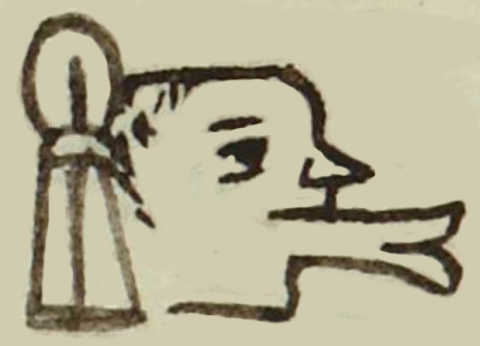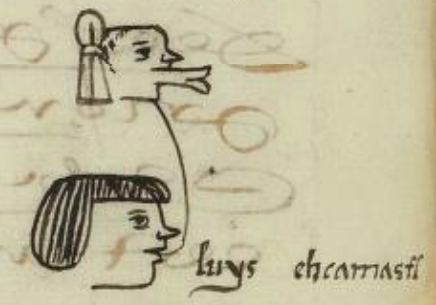Ecamaxtla (MH727v)
This black-line drawing of the compound glyph for the personal name, Ecamaxtla (perhaps, literally, “Air-Loincloth”), shows an anthropomorphic face in profile, looking toward the viewer’s right. The face wears a buccal mask of the type that Nahua religion attributed to the divine force of the wind (Ehecatl) and through which he was believed to blow the wind around. To the left of this head is a loincloth, apparently made of white cotton, and tied in a knot.
Stephanie Wood
Ecatl (or, here, Ehcatl) is a common spelling for Ehecatl (wind), and yet Ecatl may have its own separate meaning (air, breath). Ehecatl was a day name in the tonalpohualli, 260-day divinatory calendar, which increased its likelihood as a personal name. But how does it combine with maxtlatl (loincloth)? There was a tlatoani (famous ruler) named Maxtla, son of Tezozomoc, who was the head of the empire based in Azcapotzalco in the fifteenth century. Perhaps this person has a name that recalls the power of that leader.
Stephanie Wood
1560
Jeff Haskett-Wood
aire, viento, aliento, taparrabos, nombres de deidades, nombres de hombres, nombres famosos

eca(tl), air, breath, https://nahuatl.wired-humanities.org/content/ecatl
eheca(tl), wind, https://nahuatl.wired-humanities.org/content/ehecatl
maxtla(tl), loincloth, https://nahuatl.wired-humanities.org/content/maxtlatl
literalmente, Aire-Taparrabos
Stephanie Wood
Matrícula de Huexotzinco, folio 727v, World Digital Library, https://www.loc.gov/resource/gdcwdl.wdl_15282/?sp=533&st=image
This manuscript is hosted by the Library of Congress and the World Digital Library; used here with the Creative Commons, “Attribution-NonCommercial-ShareAlike 3.0 License” (CC-BY-NC-SAq 3.0).





